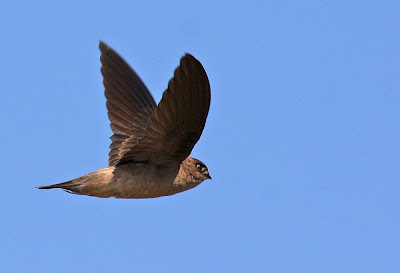A family visit to KL allowed me a chance to visit Kapar on a couple of afternoons when the tides were good.
On the 28th I was accompanied by Ooi Chin Hock. The sky was quite overcast and the birds flighty, so photography was a challenge.
One of the very first birds we saw was a male White-faced Plover. During the 1990s I and several other observers recorded 'Malaysian Plovers' at Kapar. In retrospect, what we saw must have been White-faced Plovers, as Malaysian are rarely recorded on the west coast, and never away from sandy beaches. It was good to confirm that Kapar is still used as a wintering site for White-faced Plovers. Later we counted 13 feeding on the far side of the pond.


Repeated scanning of the enormous roosting flocks eventually yielded fruit. First, this attractive leucistic Lesser Sand Plover, with pink legs!

Then this rather odd breeding plumaged Lesser Sand Plover. Presumably it never moulted at the end of the last breeding season.

Brahminy Kites often harass the wader flocks, but I had not seen them actually catch a bird until today.

All that was left after the meal! Some feathers enabled us to identify the bird as a small Calidrid sandpiper, perhaps a Red-necked Stint or Curlew Sandpiper?

It was great to see a few Nordmann's Greenshanks (on the right of the Common Greenshank in this picture) - we counted four - our first of the season.

This pic shows a good comparison of the difference in leg and bill structure and colouration between Nordmanns' (right) and Common Greenshank.
Here's a video of the same bird.

This still from the clip above shows how distinctive Nordmann's is even from a distance (the bird is third from the right). The pale grey wings (with a darker 'shoulder' patch sometimes visible, paler head, thicker bill, shorter, thicker legs and deeper body shape all add up to quite a distinctive species, in some ways more reminiscent of Terek Sandpiper than Common Greenshank.

After three and a half hours of scanning the flocks, we finally turned up an ace in the pack! This Spoon-billed Sandpiper may be the same bird I saw last April. It stayed put long enough for me to take one sharp photo, and to get Chin Hock his life bird, and then the whole flock was disturbed by a marauding Brahminy Kite and we couldn't locate it again.
On the 29th, the weather was even more overcast, with frequent rain, and the birds were as skittish as ever, preferring the more remote corners of the ashpond. With photography out of the question, I concentrated more on counting. I located the white leucistic Common Redshank first seen on 17th August, and a Greater Sand Plover with orange legs (the same as or similar to one I saw earlier in the year), but not the leucistic Lesser Sand Plover, nor the Spoon-billed Sandpiper. Best of all was an exceptional count of 35 Nordmann's Greenshanks (compared to only 4 yesterday).
Taking the best species counts from both days, just under 19,000 waterbirds were present over the two days:
Pacific Golden Plover 3
Grey Plover 200
Little Ringed Plover 20
Kentish Plover 2
"White-faced" Plover 13
Lesser Sand Plover 4,000
Greater Sand Plover 2,000
Black-tailed Godwit 150
Bar-tailed Godwit 15
Eurasian Curlew 4,900
Whimbrel 100
Common Redshank 2,470
Common Greenshank 350
Nordmann's Greenshank 35
Marsh Sandpiper 150
Terek Sandpiper 100
Common Sandpiper 1
Ruddy Turnstone 7
Red Knot 1
Great Knot 300
Red-necked Stint 2,500
Spoon-billed Sandpiper 1
Curlew Sandpiper 400
Broad-billed Sandpiper 25
White-winged Tern 250
Gull-billed Tern 736
Caspian Tern 24
Little Tern 5
Lesser Adjutant 1
Grey Heron 2
Great Egret 2
Little Egret 60
pond heron sp 1
Little Heron 2
TOTAL 18,916

Wall to wall waders! If you find the Spoon-billed Sandpiper let me know!
A good end to the year. Here's wishing you an excellent and happy New Year!s







































